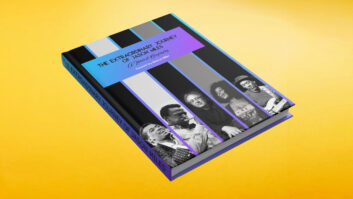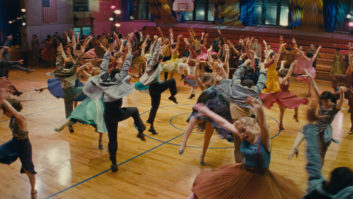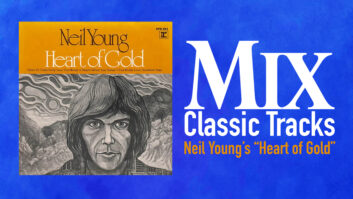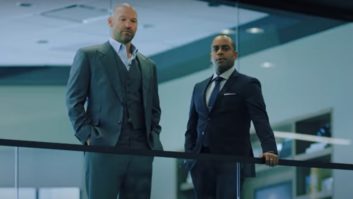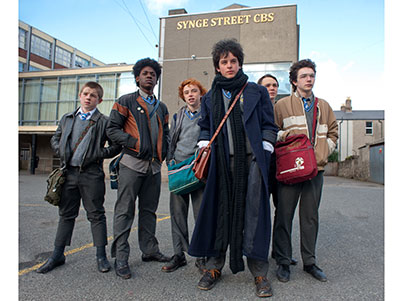
Some animals lock horns, or bare teeth and claws, to physically dominate their competition. Other species inflate random body parts in magnificent display to catch the eye of a potential partner. But for that special breed of human known as the teenager, an effective way to attract a mate is to play in a band. Director John Carney’s latest film, Sing Street, captures this timeless mating display. Set in 1980s Dublin, Ireland, a teenage boy seeking to impress a girl convinces his friends to form a band. But unlike most high school bands, the Sing Street group has the benefit of professional musicians and the magic of filmmaking to boost their appeal.
Using professional musicians and syncing the sound in post is a departure for Carney, who had taken a “what you see is what you hear” approach on a previous film, Once (2007). “Sing Street involves a full band, which makes it more complex to capture live performances on set. Also, the young lads are all inexperienced actors,” says Sing Street co-supervising sound editor Niall Brady (with Michelle Fingleton), who also supervised the sound on Once. Not only did the young actors have to learn their parts for the film, but they also had to rehearse all the songs so their performance on-screen would sync with the studio musicians’ tracks. Even for his musical-dramedy Begin Again (2013), starring Keira Knightly as a singer-songwriter, Carney used Knightly’s own performances of the songs— although they were recorded in the studio, not captured on location.
As Carney was finishing up Begin Again, he popped in to see music producer Kieran Lynch who owned a studio in Dublin’s The Factory, a collective community of film industry artists founded by Carney and director Kirsten Sheridan. “John [Carney] pitched the idea for Sing Street to me and a couple of other people in The Factory. His initial idea was slightly based on his own childhood and his experience while in that school,” says Lynch. The school in the film is the same one that Carney had attended.
Since music is so central to Carney’s films, work began on the songs long before the film was shot. In November 2013, Lynch hired keyboard player Graham Henderson, drummer Karl Papenfus and his brother, guitarist Ken Papenfus. Together with Carney on guitar and his friend, bassist Eamonn Griffin, they held once-a-week writing sessions in the control room of Lynch’s studio. Carney would pitch an idea for a scene or present a rough song idea, and the group would flesh it out and try to structure it based on the needs of the scene. By December, they had five songs. Those sessions also produced a friendship between Henderson and the Papenfus brothers. “They got along so well as people that Graham, who is the musical director for Sinead O’Connor, asked them to join her band. They have been playing with her ever since.”
Music Production
In August 2014, a month before principal photography began, the studio band reunited at Windmill Lane Recording Studios in Dublin. Songwriter Gary Clark, frontman for ’80s band Danny Wilson, joined Carney as co-writer of the final tracks, which pay homage to period favorites like The Cure, Duran Duran, Hall & Oates and Elvis Costello. Lynch notes that those different song styles didn’t impact his approach to recording the tracks. What was more important was how the songs would fit into the film. It needed to sound like the kids on-screen were actually playing the songs, and the songs also needed to transition into full studio versions for the score sections.
To cover both approaches as efficiently as possible, Lynch used different mic setups at varying distances for each instrument. “When the scene happens in a sitting room or the bedroom, you want the music to sound as close and intimate as possible,” says Lynch, who had to make decisions on mic selection and setup without the benefit of picture. “Then, when the camera moves back and you have a wide shot, you want to be able to give it more space sonically. All we had was the script and a basic concept of what would be happening, so you have to try and imagine how the scene will be set up and hope that you have the flexibility when it comes to fitting in the track.”
While the music for Sing Street’s on-screen band is pure studio magic, lead actor Ferdia Walsh-Peelo, playing the part of Conor, actually performs his vocals. Lynch had the foresight to record Walsh-Peelo’s vocals using a Neumann KMR 81 shotgun mic and a DPA 4060 lav mic to match the production sound captured by location sound mixer Robert Flanagan. This made it much easier for the post sound team to transition between the dialog and the diegetic music moments. Lynch also had an AKG C12 VR and a Shure Beta 58 paired with two UREI 1176 mic preamps on the vocals to capture a richer studio sound for when the songs go into full-on score.

From L-to-R: Gary Clark, Ciaran Bradshaw (recording engineer on session), Eamonn Griffin, Keiran Lynch, Ken Papenfus, and John Carney
Another factor in helping the audience believe that the music was coming from the band on-screen was to have the professional musicians play like amateurs. Lynch says, “It was a challenge getting session musicians to play poorly but not play so badly that it was terrible. I kept having to tell them to play like a 15-year-old kid who believes that he is amazing but actually isn’t. With this film I tried my hardest to get it to feel real and authentic, to make it as believable as possible so that the audience isn’t taken out of the film ever, not even for an instant.”
Windmill Lane Recording Studios is outfitted with a Neve Legend VR-72 console, KRK V8 near-fields, and Genelec 1038CF far-field studio monitors. Manning the controls for Lynch was recording engineer Ciaran Bradshaw. Lynch and Bradshaw did additional recording at Westland Studios in Dublin on an SSL 4048 E Series. Music mixing for the film was done at Dublin’s The Cauldron Studios on a TL Audio VTC console. Lynch prepared an extensive set of stems for the post sound team. He split out all the elements, including the guitar effects, onto separate tracks, giving re-recording mixer/post-production music mixer Ken Galvin ultimate flexibility.
On to Post
At Ardmore Sound, located in Bray, County Wicklow, Ireland, supervising sound editors Brady and Fingleton handled the effects, backgrounds, Foley (with Foley mixer Jean McGrath and Foley artist Caoimhe Doyle), loop group and ADR (assisted by sound editor Peter Blayney).
Meanwhile, Galvin tackled the challenge of cutting between all of those studio-recorded tracks to make the music fit the needs of each scene. In the film, the band practices in a bedroom and a living room, and they record themselves onto cassette tape, which they play back while shooting their music videos in an alleyway and on a pier. There are fantasy sequences, and a stage performance in the school auditorium. There’s even a fantasy sequence of their school performance. The challenge was to sell the believability of the music coming from the band on-screen, and then transition fluidly into a full-on score that plays over the scene.
Each situation required Galvin to employ a unique processing chain of EQ, reverb and other effects, in addition to panning and mixing. Working in Avid Pro Tools 11, Galvin chose FabFilter Pro-Q for EQ. For reverb he chose Audio Ease’s Altiverb and on the vocals he went with Avid’s ReVibe. To add a bit of grunge, he found that Avid’s SansAmp PSA-1 amplifier emulator and the LoFi plug-ins did the job. The Varispeed feature of Avid’s Time Shift plug-in and Serato’s Pitch ‘n Time provided convincing cassette tape flutter and wow. Waves H-Delay was useful when syncing the music in sections of the school performance scenes.
“The music was the device that moved the perspective from Conor’s small, hard world into something that was much more magic and exciting,” says Fingleton. A good example of their approach to the music transitions happens on the 360-degree pan shot of the band as they’re starting to write a song called “Up.” It begins with just Conor and his friend Eamon (played by Mark McKenna) playing guitar and piano at night. Then the camera tracks around, night becomes day and the rest of the band are suddenly present. The bass, drums, and keyboard come in one by one. As the camera pans back around to Conor and Eamon, the music has evolved from diegetic to score. “You get to experience the journey of the song from an idea to a fully formed pop song.”
To pull off the music transition, Galvin says, “We wanted to hit each member of the band, so [mix-wise] they just got a little nudge. We wanted the sound to not be so even while they’re playing in the scene, and then it goes into score.” Working on Ardmore’s main dub stage—equipped with two Avid Icon D-Control surfaces running four Pro Tools systems, Galvin started small by panning mono tracks of the individual instruments and then branched out into the full 5.1 surround as more instruments, guitar effects, and vocal layers were added, building up to the full score. In addition, he slowly pulled out the sound effects, backgrounds, and Foley to further emphasize the move away from the real world.
The sound effects were integral in helping to work the studio-recorded tracks into the world on-screen. For example, Fingleton had asked Lynch to record some wild sounds in the studio, like guitar handling movements and feedback, which she then cut in to add a live feel to the band’s school performance. She and Brady recorded loop group with teenage boys yelling insults and other reactions since the crowd isn’t very into the performance at the on set. For that scene, Galvin notes he was able to use a bit of the boom mic track as an effect. Since it had picked up the playback of the song in the space, it was useful for when the camera is in a wide shot at the back of the auditorium. “The playback from that day just adds a little dirtiness, a little bit of grit in the mix,” Galvin says.
Since Carney attended the school where Sing Street was filmed, and actually played in a band on that exact stage, he had a very clear idea of how that scene should sound. Galvin explains, “He knows what those insults are and he knows what the perspective sounds like from the stage. Again, it’s the band’s first gig and so, for the first song, the instrumentation is a bit off-balance on purpose but as the song grows and develops they become a little more in tune with each other.”

